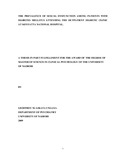| dc.description.abstract | sexual dysfunction can impact a person's ability to form or sustain intimate relationships
and has been found to interact with mental health conditions such as anxiety and depression yetepidemiological,etiological, and health association to sexual dysfunction has only begun to be explored. The result of research to date indicates that neurovascular mechanisms maybeimportant for both sexes (Heiman, 2001). Diabetesmellitus, among the chronic conditions is on the increase in the society and due to associated complications of which sexual dysfunction is one; the researcher will endeavor
to show how prevalent it is in the society (Kenya).
Diabetes has been associated with sexual dysfunction in men and women. Neuropathy,
vascular insufficiency, and psychological problems have been implicated in impotence,
impaired ejaculation and decreased libido in men and in decreased vaginal lubrication,
orgasmicdysfunction and decreased libido in women (Zemel, 1988).
Although prevalence on sexual dysfunction has been widely researched on in the western
world, little has been done in Africa including Kenya where studies specific to the study
being undertaken are yet to be carried out.
Setting: The outpatient diabetic clinic at Kenyatta National Hospital.
Objective: To establish the prevalence of sexual dysfunction among patients with diabetes
mellitus.
Design: A descriptive cross - sectional study.
Sampling method: Purposive sampling.
Participants: A total of 350 participants making up the sample size were involved in the
study.
Data Collection Instruments: This was by use of: Researcher prepared sociodemographic
questionnaire, Female Sexual Function Index and the International Index of Erectile Function.
Data analysis: The data was analyzed by a computer data base developed using statistical package for social sciences (SPSS). The results were presented in descriptive form using
frequency tables, bar charts and narratives.
Results: 350 respondents were studied of whom 186 were males and 164 were females at a ratio of 1.134: 1. The age range was 18-100 years in general, where for females it was 18-74 years and 19-100years for the males respectively. The mean age was 50.4 years for males 44.6years for the females. The standard deviation was 14.5 for the males and 13.5 for females.The gender age difference was significant with males being older than females (p<O.OOI). The mean age onset of diabetes was 43.4 years males and 38.2 years in females that wasstatistically significant, P<O.OOI.
Prevalence of sexual dysfunction was assessed using standard measures of FSFI and lIEF for females and males respectively. In males prevalence of sexual dysfunctions was:
erectile dysfunction (68.8%); orgasmic dysfunction (48.4%); sexual desire (81.7%);
intercourse satisfaction (86.6%) and overall satisfaction (68.4%).The female sexual
dysfunctionwas 36.6% and was categorized as mild (17.1 %); moderate (18.3%) and severe (1.2%). In regard to the types of sexual function which were independent of each other, the dysfunctionswere: desire (76.8%); arousal (60.4%); lubrications (35.4%); orgasm (43.9%); satisfaction (28.0%) and pain (14.6%). On multivariate analysis there was significant association of sexual dysfunction with age OR, 1.08 (1.04-1.12) <0.001 and reported sexual problem OR7.7 (3.4-17.6), P<O.OOI in females. In regard to male sexual functioning; age was associated significantly with most categories of sexual function except in male's erectile function while reported sexual problem was significantly
associated in all categories of sexual functioning. Duration with diabetes and education
were also associated with ED.
Conclusion: Diabetic patients do experience various forms of sexual dysfunction as noted
by the prevalence rates in the study for both females and males and do compare well with
prevalence rates of studies done elsewhere. Prevalence rates in this study for males were
higher in categories of erectile, orgasmic and satisfaction functions than in females and
vice versa for sexual desire and arousal which were higher in females. Age and reported
sexual problem were significantly associated, hence independent predictors in regard to
sexual functioning.
Recommendations: There is need to pay due attention to sexual dysfunctions by the health personnel in the health care system in regard to management of patients with diabetes mellitus right from the point of diagnosis. This would enable prompt intervention and appropriate treatment, both medical and psychotherapy; hence stem any would be
complications arising and therefore undue effect on the individuals' quality of life. | en |
| dc.description.department | a
Department of Psychiatry, University of Nairobi, ; bDepartment of Mental Health, School of Medicine,
Moi University, Eldoret, Kenya | |

